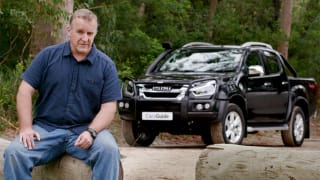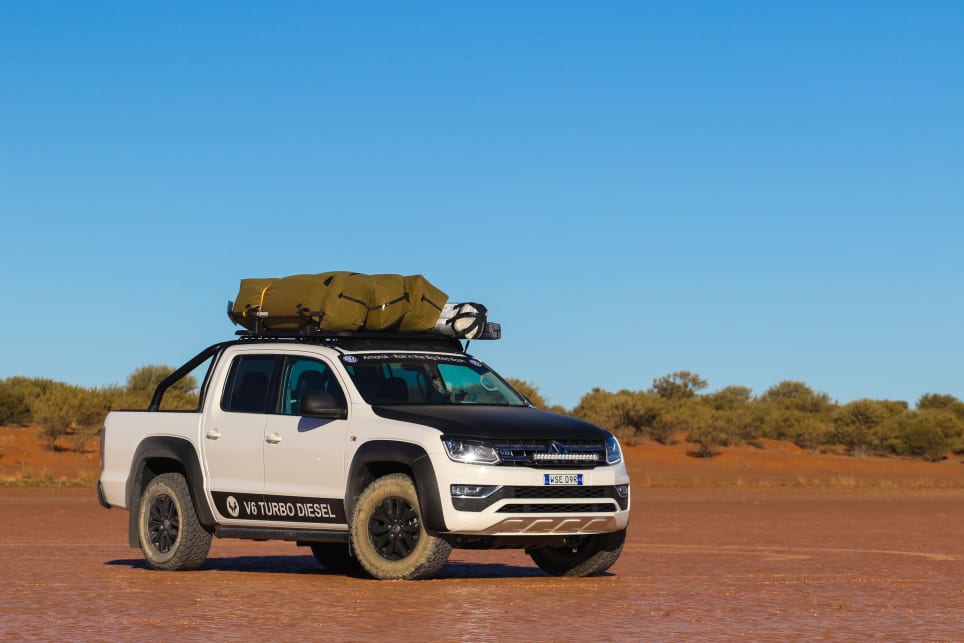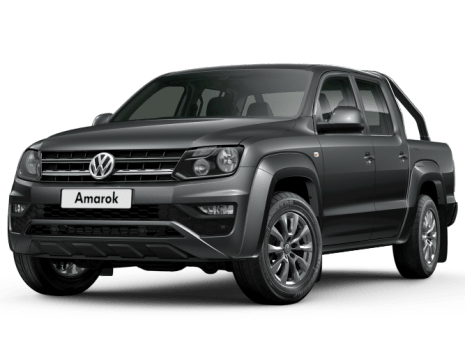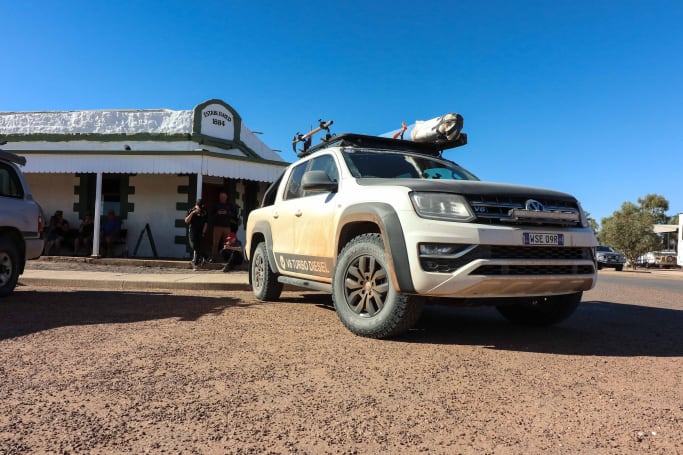
Isuzu D-Max LS-T 2017 review
Isuzu's D-Max has always been a solid middle-of-the-market ute; nothing more, nothing less. Not as slick as many of its heavily manicured and marketed rivals, but it has a real rough charm.
Browse over 9,000 car reviews

The chatter on the radio was lively… and not exactly complementary.
“Here comes another bloody one, Shirl!” squawks the CB indignantly.
“What? How many of these things are there?” replies an equally indignant Shirl.
“Dunno. Goin’ pretty fast, but,” replies Shirl’s mate darkly.
“Fast? In a bloody Amarok?” tartly opines Shirl.
This small exchange, overhead on the Birdsville Track, perfectly encapsulates the challenge Volkswagen faces when it comes to the job of winning over the hearts and minds of dual-cab ute buyers – but it’s a challenge it’s facing head on.
CarsGuide has joined the Volkswagen Australia crew on a 1200km cross-country odyssey that will take in three states and more than a thousand kilometres of dirt roads, en route to the second annual Big Red Bash music festival, which is held in the shadow of Big Red, a massive sand dune about 30km west of Birdsville.
It’s a journey that’s not undertaken lightly. The unsealed roads that intersect the borders of NSW, Queensland and the Northern Territory are graded periodically, but recent wet weather has made access a lottery.
As well, we’ll join in with Amarok owner groups from as far afield as Victoria, South Australia and Canberra, as well as Brisbane, and even Tasmania.
It’s also a trip that puts the Amarok firmly in the sights of a cross section of people who use their vehicles just as their makers intended.
| Volkswagen Amarok 2017: V6 TDI 550 Ultimate | |
|---|---|
| Safety rating | |
| Engine Type | 3.0L turbo |
| Fuel Type | Diesel |
| Fuel Efficiency | 7.8L/100km |
| Seating | 5 seats |
| Price from | $47,190 |
It’s one of the neatest and cleanest designs in the four-wheel drive (4WD) dual cab unit mix, and stands in contrast to rivals like the Toyota HiLux for the simplicity of its finish.
'Our' Ultimate V6 has been modified for the trek, but only lightly. Along with the standard sports bar in the rear of the dual cab’s ute tray, a black lockable roller shutter has been added, along with a genuine accessories-sourced roof rack and platform combo, an ARB awning and sand shovel holder.
The usual 19-inch rims have been replaced with 17-inch versions from the Amarok Canyon special edition finished in black, and fitted with 265/60 R17 General Grabber G2s all-terrain tyres.
There’s a set of rock sliders along the side of the car, but no bull bar or snorkel, as VW Australia is yet to finalise approval for factory-fitted items. A light bar with an aerial mount cleverly attaches to bracing fitted across the front of the radiator, while customised black graphics complete the look.

Our $67,990 Ultimate V6 is one of the most expensive 4WD dual cabs in play at the moment – but it has a big power advantage over rivals like the Toyota HiLux and Ford Ranger.
And it’s definitely an expensive bit of kit to be subjecting to the rough, rocky and dusty roads of our country’s wilder side…
There is a Highline grade that sells for $10,000 less, and Volkswagen tells us a Sportline version will arrive later in the year.
In terms of value when heading bush, you’ll need to factor in the cost of an alternative set of tyres more suited to the terrain, as well as a set of rims to match. The stock 19-inch rims can be fitted with off road rubber, but they are much more susceptible to damage from rocks and other debris.
As well, fitting the front of the car with some sort of stone protection device is a must; a single pass-by with a large truck or caravan will shower your Amarok with a tonne of small, sharp, fast-flying foreign objects that will crack headlights and windscreens in a heartbeat.
To get a full run down of the Amarok TDI550 Ultimate's standard specification, check out our road test.
The standout item in the Amarok V6 from our trip has to be the front seats. Put simply, they are bloody amazing. Even after a 450km stint over rough and rolling terrain, I only got a slight twinge of discomfort right towards the end of the run – and I’m super fussy when it comes to seats.
The side bolstering is spot on, the extendable base is great, the squab length is perfect, the height range is excellent and the heating elements add the final cherry.
The steering wheel, too, is easy to hang onto and is well shaped, while the main controls are easy to access.
The multimedia system is set up for Apple CarPlay (and Android Auto), allowing us to hook onto Spotify via iPhones to annoy each other with our rubbish taste in music over the long days of travelling.
A pair of slightly too-shallow cupholders up front are complemented by deep bottle holders in all four doors that can actually hold two small bottles at a pinch, while map pockets on the back seats and a medium-sized centre console bin helps to stash all the accouterments acquired over a long journey.
When you’re out bush, items like USB points and 12 volt charging bays come into their own, and the Amarok could use a couple more USB sockets scattered around the car, particularly for rear seat passengers.
Once a HEMA map screen and a battery monitor are fitted, charging slots are already running low; pack an adaptor or two if you’re out bush for a period.
The rear seats are taller than the fronts, but are just comfortable enough in terms of leg and headroom for taller passengers to travel for medium distances without discomfort.
One thing about outback driving is the sheer amount of dust that gets into everything, including the tray area. The Amarok remained impressively clean over a solid week of thrashing through sand and silt, though the roller cover over the tray did nothing to keep it out.

The Amarok’s 3.0-litre turbo-diesel V6 – as fitted to the Porsche Cayenne and Audi SQ5, no less - makes 165kW at 3000rpm, and a stonking 550Nm between 1500-2750rpm.
Those power and torque figures are already impressive for a ute, and are even more impressive when overboost is factored in, which is available from 70 per cent throttle in third or fourth gear. It chips in an extra 15kW for a total of 180kW and 30 extra Nm for a total of 580Nm.
Getting to the bush is half the trip for an outback adventure, and the biggish six easily propels our fully laden Amarok over coarse country tarmac at the national limit, even with a full load of swags on the roof.
Basically, the Amarok did it easy.
When the sealed roads disappear, the mid-range punch of the V6 comes into its own, while the full-time 4WD system sends 60 per cent of its torque rearwards. An off-road mode divides the power 50/50 between the two, and while stability control can be partially disabled, it can’t be switched all the way off.
You can leave the excellent eight-speed auto to its own devices, or flick it over to manual mode and control it via wheel-mounted paddles, which is handy when blasting up a deep, sandy dune face and you need uninterrupted power.
We measured a full tank run from Camerons Corner to Broken Hill, which took us over 388km on dirt roads, and the Amarok devoured 74 litres of diesel, leaving us just over five litres in the tank before we ran dry in the desert. Ulp.
Despite a dash-indicated fuel reading of 15.1L/100km, the actual figure is more like 19.0L/100km. This is pretty indicative of dirt driving, though it’s a heck of a long way north of the claimed combined fuel economy figure of 7.8L/100km.
Over 1200km (which incorporated about 80km of tarmac), the figure fell to 17.9, with 215 litres of diesel added to the tank over three stops.
We were fully laden with gear, complete with a very un-aerodynamic load of swags across the top of the rig, while the (surprisingly) undulating terrain and extra drag of the offroad tyres all added to the total.

Fortune, and the timetable of the road grading program, fell perfectly for us, with all but the last 100km of dirt in excellent – if dusty - condition. With a fully laden Amarok, our pace was steady and solid, and the V6 ate up the long stints with consummate ease.
Pushing the off-road mode button added noticeable additional torque to the front axle, and is also a contributor to our appetite for fuel. With full-time 4WD always on hand, the relatively smooth dirt allowed us to limit the off-road mode for when we really needed it.
The rear-biased drive system gives the Amarok a bit of character, while its compliant suspension tune still offers support in the middle of the stroke, despite the estimated 300kg of payload on board. Steering is excellent for a 4WD ute, and the braking performance is top notch, too.
In fact, off-road mode lengthens the pulse distance of the ABS, allowing the tyres to build up small dirt ridges in front of them to reduce stopping distances.
Basically, the Amarok did it easy, and it felt liked there was a bit left in reserve if the going suddenly got a bit nasty. The General tyres did an admirable job at high and low pressures, though we didn’t have a chance to try them in muddy conditions.
A close encounter or seven with thick-headed kangaroos did highlight the lack of a bullbar on our car, though, which is almost a prerequisite for going bush.
Basic Warranty
3 years / unlimited km warranty
ANCAP Safety Rating

Unfortunately, the Amarok range lags behind its main competitors when it comes to driver aid safety gear and curtain airbags, neither of which are currently (or ever likely to be) available on the car.
Despite holding a top five-star score from 2011, the Amarok’s lack of features like AEB, blind spot warning and trailer sway control, as well as full length curtain airbags that cover the rear seat passengers, do this otherwise solid performer no favours.
The Amarok offers a three-year/unlimited km warranty, while services are recommended every 15,000km or 12 months.
Fixed price service program costs are $470, $663, $557, $824 and $470 respectively for the first five visits, totalling $2984 all up.
If you drive like we did on this test, though, it’s wise to shorten the service interval to ensure items like the air filter, underbody parts and tyres remain in good nick.
We expected to go to Birdsville in an Amarok and be laughed out of a town rammed full of Toyotas, but my theory was debunked almost immediately. Aussie buyers aren’t abandoning the brand that helped to open up the outback by any means, but there are plenty of other rigs starting to show up, dusty and dirty, in outback townships.
The Amarok’s penetration will always be limited in the bush by a lack of rural dealers, but in terms of being a valid, relevant product for a tough environment, it deserves a place at the outback pie shop table.
There will still be snide asides made by the diehards for a few years yet, but don’t be surprised to see more and more Amaroks, carrying the marks of a week in the bush, turn up in your office car park on a Monday morning.
| Vehicle | Specs | Price* | |
|---|---|---|---|
| TDI400 (4X4) | 2.0L, Diesel, 8 SP AUTO | $19,360 – 24,530 | 2017 Volkswagen Amarok 2017 TDI400 (4X4) Pricing and Specs |
| TDI340 (4X2) | 2.0L, Diesel, 6 SP MAN | $20,350 – 25,740 | 2017 Volkswagen Amarok 2017 TDI340 (4X2) Pricing and Specs |
| TDI420 Core Edition (4x4) | 2.0L, Diesel, 8 SP AUTO | $20,240 – 25,630 | 2017 Volkswagen Amarok 2017 TDI420 Core Edition (4x4) Pricing and Specs |
| TDI420 (4X2) | 2.0L, Diesel, 8 SP AUTO | $23,100 – 28,490 | 2017 Volkswagen Amarok 2017 TDI420 (4X2) Pricing and Specs |
| Design | 8 |
|---|---|
| Price and features | 7 |
| Practicality | 8 |
| Under the bonnet | 9 |
| Efficiency | 7 |
| Driving | 9 |
| Safety | 6 |
| Ownership | 7 |
$13,990
Lowest price, based on 166 car listings in the last 6 months